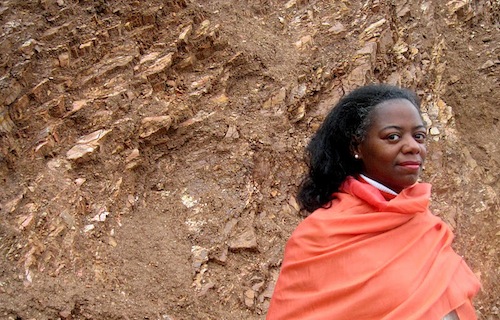
One of the problems with writing about poems, and especially with writing about poems that are trying to reach something that isn’t articulable in language, is that it’s impossible. & impossibility aside, what would be the point? As though you’re going to come along and say, “This is what you, poet, were trying to get at.” A familiar enough problem, but that doesn’t mean it’s not a problem (all the worst problems are familiar).
I refuse to bring up the RNC, except just to say that I was unlucky enough to catch Donald Trump, Jr. describing Donald Trump, Sr. as one who “achieves the impossible.” I think it stuck with me because it’s a moment in which the funhouse nightmare of American public discourse seemed to reflect something real. Trump’s about harnessing fantasy to achieve the all-too-possible, the all-too-familiarly murderous. But what if giving up, trying to give up, the fantasies of dominance and control could lead to an impossibility worth achieving, call it peace or love or understanding? Could reading actually have something to do with that?
Such, at least, are the kind of reflections I find myself having while reading giovanni singleton’s Ascension, and particularly that book’s long poem “ear of the behearer.” It’s a daybook in 49 sections, composed during the 49 days that Alice Coltrane passed through the bardo, the transitional period between death and rebirth in Tibetan Buddhism. I will confess that, despite being a poet for some time and a West Coast-based one at that, I had to do a little reading around on the bardo, which is theorized prominently in the text translated into English as The Tibetan Book of the Dead, although a more accurate rendering of the Tibetan is The Great Liberation by Hearing in the Intermediate States. In the context of the bardo, the liberation is achieved by hearing the text itself, as it’s intoned to the dying person. But the suggestion is, I think, clear in singleton’s title that this poem is also going to be a guide by way of hearing, of attending to subtle and jagged music. And what could be more fitting as a memorial of Coltrane, who followed her ears to singular vistas of aesthetic, social, and spiritual liberation?
Day 1 reads, in its entirety:
feather
rattlesky sky
drum
turtlecry cry
talking
stickeye eye
fire in
the skull
A lot’s packed into those sixteen words. They announce the syncretic, spiritual aspiration of the series, as well as the predominant method of the poems: a paring away to approach the communicative limits of language. They also manage to build a startlingly complex musicality out of simple units. Notice, for instance, how shifting the accent onto that final “skull” both recollects the earlier unstressed “-le”s of “rattle” and “turtle” and gives the sound a decisive finality. Or how cutting “sky” and “cry” down to “eye” anticipates the book’s final typographical poem, in which a page-sized “I” is followed first by a similarly large “i” and then a single dot. The interplay of this earlier poem and that one suddenly makes that dot seem like the book’s iris, its looking back to itself, its looking back at me, rejuvenating one of the more familiar puns in the language (“I/eye”). And now that seems to confirm for me my sense that the “talking/stick” here is on one level the pen which animates these words: the poem’s peculiar liminality, between the animate and the inanimate, turns out not to be so peculiar after all—it’s the mystery of the “fire in/the skull.”
That mystery links us to the animals, living and dead, that (I wind up thinking) “people” many of the poem’s sections. Day 12’s “dead fox” by the side of the road, for instance. That points me back toward Ciavonne’s sackcloth animal, & also to Lucille Clifton’s fox poems. The first connection’s idiosyncratic; the second, I think, not so much, given that singleton’s cited a line from that Clifton collection as her favorite line of poetry. And given, too, the poem’s concern with its African-American foremothers: not just Coltrane and Clifton, but (as the litany in day 27 has it) “Sojourner Truth Harriet Tubman Toni Cade Bambara/ Mahalia Jackson Shirley Ann Hemphill Isabel Sanford/ Shirley Chisholm Clara Ward Nell Carter Lynne Thigpen.” singleton’s work keeps gesturing out at a constellation of reference points, a social world marked by anti-black violence and oppression, but also by “the soul’s cast iron/ clapper,” the deep ring of resistance and the myriad beauties of dailiness.
But dailiness’s terror, too: that dead fox on the road. For me, at least, a recurrent feature of this work is the oscillating move between dispersion—connecting moments in the text to other moments, other texts—and concentration: coming back to these particular words on the page. That concentration is enabled by the lapidary concision of these poems, the silence that surrounds them. Despite the poet’s own stated second thoughts—day 23 reads in its entirety “Too much pruning brings misfortune,” & I find myself recurrently coming back to this, because it puzzles me (where’s the misfortune? is this, the shortest entry in the daybook, the result of too much pruning? is it a kind of quarantine?)—the hush of these sparse couplets, enigmatic anecdotes, puns seems continuously illuminating, on the track of what can’t be put exactly into words.
On day 38, an unnamed pair
drop oars
in water
row beyond
light &
shadow
I can’t help thinking that “row beyond” is a pun, not just the sound of that silent splash, but the line of writing beyond the light and dark that make up these words on the page. It’s what keeps sending me out from her poem and bringing me back, the sense of the words beyond those found in its pages.
John Beer is the author of the poetry collection The Waste Land and Other Poems (2010), winner of the…
Read Full Biography

